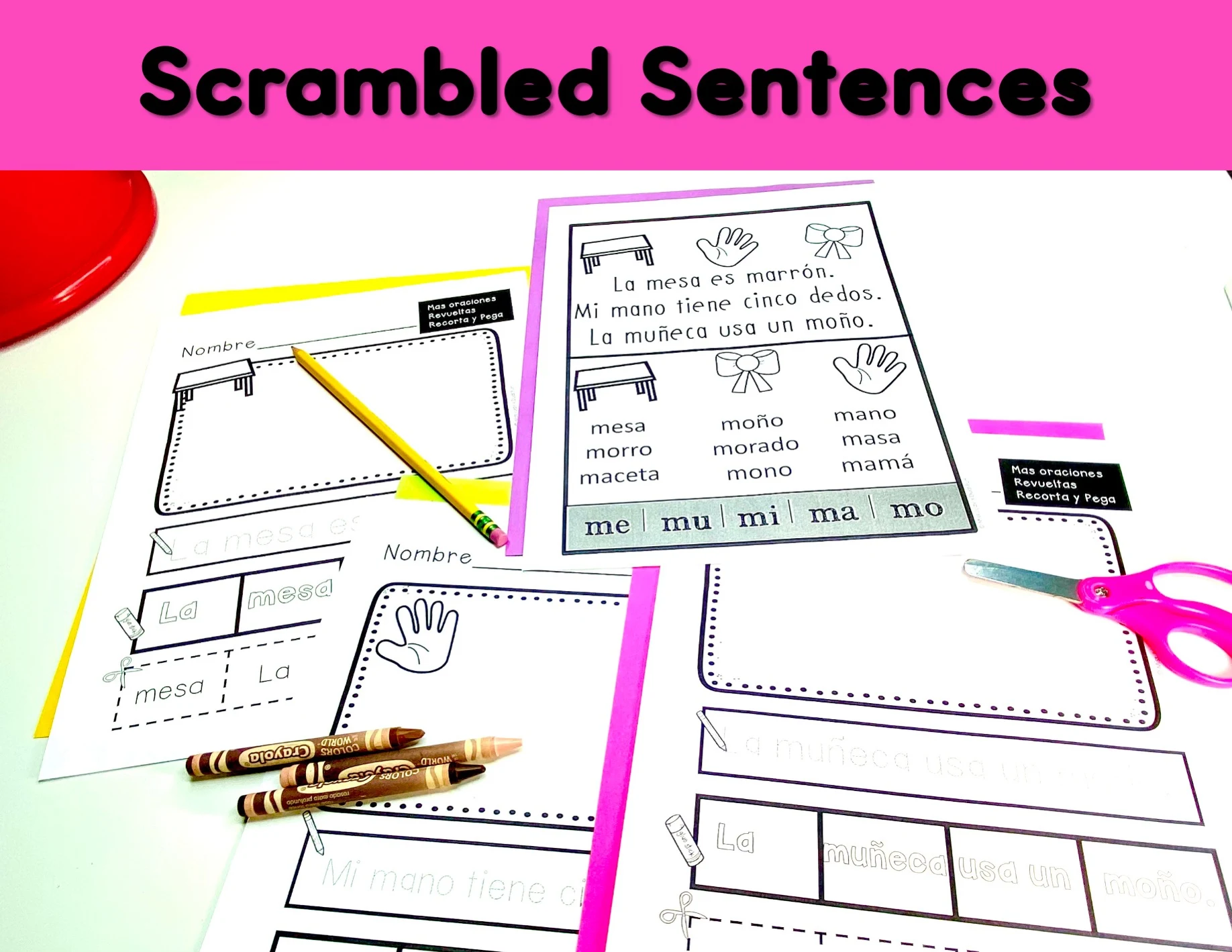Have you ever wondered: "What are scrambled sentences?" Or have you doubted the efficacy of scrambled sentences in your Bilingual or Dual Language Kinder or First Grade classroom? This post will inspire you to incorporate scrambled sentences into your bilingual literacy practice so that you can reap the benefits of this simple yet powerful learning tool.
If you are looking for bilingual literacy resources, then scroll down to the bottom of this page to the blue bar to take advantage of my resource library. You will sign up for my newsletter so that you can gain access to exclusive freebies and bilingual literacy teaching tips!
Scrambled sentences stand out here because scrambled sentences are a pretty simple approach, but with some deep benefits, especially in dual language where some kids are learning Spanish and English, and all kids need to learn to read in both languages.
1. Unlocking Cognitive Flexibility
Bilingual literacy demands a high level of cognitive flexibility because our learners are navigating between two linguistic systems. Scrambled sentences are super useful in this regard as learners are challenged to rearrange words into coherent sentences in the target language, in this case Spanish. This process not only reinforces understanding of grammar an syntax but also stimulates cognition crucial for language switching and processing.
2. Deepening Grammar and Syntax Knowledge
Grammar and syntax form the backbone of any language. In the context of bilingual literacy the ability to understand and manipulate these elements in a second language is vital. Scrambled sentences push learners to apply grammar rules actively and to recognize syntactical structures, and this will deepen their comprehensions and fluency in the language.
3. Enhancing Vocabulary Retention
 |
| Click to see this resource on Teachers Pay Teachers |
Vocabulary acquisition is a cornerstone of language learning. Scrambled sentences introduce learners to new words within context, promoting better retention and recall. By engaging with the language actively, learners are more likely to remember and use new vocabulary in their speaking. This is a key step towards bilingual literacy.
4. Promoting Active Engagement
Learning a second language requires active participation, and scrambled sentences provide a perfect platform for this. The hands-on approach of rearranging sentences keeps learners--especially young learners--engaged and motivated, turning the learning process into an interactive and enjoyable experience, this active engagement is crucial for long-term language retention and mastery.
5. Fostering Reading Comprehension
Improving reading comprehension in a second language is a major goal of bilingual literacy programs. Scrambled sentences help achieve this by requiring learners to understand the context and meaning of sentences to rearrange them correctly. This practice translates directly to better reading comprehension skills, as learners become better at reading words and sentences plus extracting meaning.
 |
| Click on the image for more details in my TpT store. |
6. Making Learning Fun
Probably one of the most overlooked aspects of language learning is the importance of fun. Scrambled sentences, with their puzzle-like nature, bring and element of play into education. This not only takes away the stress of learning a new language, but it also creates motivation and retention because kids are having fun.
7. Practical Ways to Teach Bilingual Literacy (bi-literacy) with Scrambled Sentences
 |
| Click to view the resource in my TpT store. |
The 'How-tos' for using this scrambled sentences resource are fairly simple. There are a number of ways that you can incorporate this resource into your routine.
1. The resource is set up for you to make a booklet for students. You can use all the pages, or just the ones that you pick. Included is a cover. I have done this and used it as an 'early finisher' activity.
2. I have used this resource many times for intervention. There is an introductory sheet that has three sentences on it along with new vocabulary words and sentences. The next three pages provide one page per sentence. Each page has an area for students to illustrate, to trace the sentence with a pencil, and to trace the sentence with a marker. Then they cut the words out and paste them in place on top of the last traced sentence.
3. You can utilize this resource as a center once you have introduced to the class the routine. I would introduce the routine in a "I Do-We Do-You Do" whole group fashion first, and allow the class to complete the 'You Do' part two or three times to be sure that they have understood the routine well.
In Conclusion
Bilingual literacy is filled with challenges and opportunities. Scrambled sentences offer a unique, effective and fun way to promote language skills, giving learners the tools they need to succeed in their bilingual path. by incorporating scrambled sentences into their daily school routine, learners can gain new levels of language proficiency, and this opens the door to a world of communication and understanding.
 |
| Save this pin for later |
If you enjoyed reading this, or if you love the idea of incorporating scrambled sentences into your daily literacy routine, then please share this post and leave a kind comment below.



No comments
Post a Comment